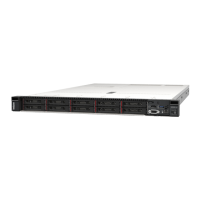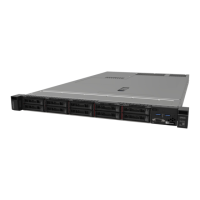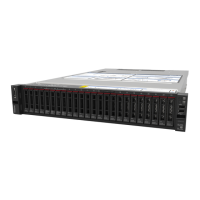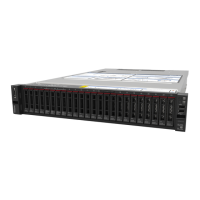Step 1. Check the event log and resolve any errors related to the power.
Note: Start with the event log of the application that is managing the server. For more information
about event logs, see
“Event logs” on page 299.
Step 2. Check for short circuits, for example, if a loose screw is causing a short circuit on a circuit board.
Step 3. Remove the adapters and disconnect the cables and power cords to all internal and external
devices until the server is at the minimal configuration for debugging that is required for the server
to start. To determine the minimal configuration for your server, see “Minimal configuration for
debugging” in
“Technical specifications” on page 3.
Step 4. Reconnect all AC power cords and turn on the server. If the server starts successfully, reseat the
adapters and devices one at a time until the problem is isolated.
If the server does not start from the minimal configuration, replace the components in the minimal
configuration one at a time until the problem is isolated.
Resolving suspected Ethernet controller problems
The method that you use to test the Ethernet controller depends on which operating system you are using.
See the operating-system documentation for information about Ethernet controllers, and see the Ethernet
controller device-driver readme file.
Complete the following steps to attempt to resolve suspected problems with the Ethernet controller.
Step 1. Make sure that the correct device drivers are installed and that they are at the latest level.
Step 2. Make sure that the Ethernet cable is installed correctly.
• The cable must be securely attached at all connections. If the cable is attached but the problem
remains, try a different cable.
• Make sure that the cable rating is applicable for the network speed selected. For example, an
SFP+ cable is only suitable for 10G operation. An SFP25 cable is needed for 25G operation.
Likewise for Base-T operation, a CAT5 cable is required for 1G Base-T operation while a CAT6
cable is required for 10G Base-T operation.
Step 3. Set both the adapter port and the switch port to auto-negotiation. If auto-negotiation is not
supported on one of the ports, try configuring both ports manually to match each other.
Step 4. Check the Ethernet controller LEDs on the adapter and server. These LEDs indicate whether there
is a problem with the connector, cable, or hub.
Although some adapters may vary, when installed vertically the adapter link LED is typically on the
left of the port and the activity LED is typically on the right.
The server front panel LED is described in “System LEDs and diagnostics display” on page 36.
• The Ethernet link status LED is lit when the Ethernet controller receives a link indication from the
switch. If the LED is off, there might be a defective connector or cable or a problem with the
switch.
• The Ethernet transmit/receive activity LED is lit when the Ethernet controller sends or receives
data over the Ethernet network. If the Ethernet transmit/receive activity is off, make sure that the
hub and network are operating and that the correct device drivers are installed.
Step 5. Check the Network activity LED on the server. The Network activity LED is lit when data is active on
the Ethernet network. If the Network activity LED is off, make sure that the hub and network are
operating and that the correct device drivers are installed.
Network activity LED location is specified in
“Troubleshooting by system LEDs and diagnostics
display” on page 301.
314
ThinkSystem SR630 V4 User Guide

